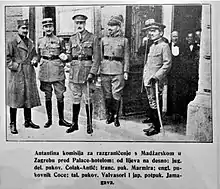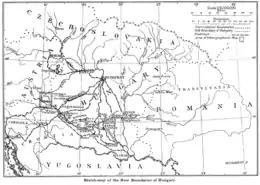Yugoslav-Hungarian Boundary Commission
The Yugoslav-Hungarian Boundary Commission (French: Commission de délimitation des frontières entre la Yougoslavie et la Hongrie) was the main body in charge of defining the new frontier between Hungary and the Kingdom of Serbs, Croats and Slovenes after the First World War, following the Paris Peace Conference and the dissolution of Austria-Hungary.[2]
Commission de délimitation des frontières entre la Yougoslavie et la Hongrie | |
 The members of the Yugoslav-Hungarian Boundary Commission | |
| Formation | 4 June 1920 |
|---|---|
| Dissolved | 10 July 1924[1] |
| Purpose | Surveying and mapping the Yugoslav-Hungarian states border |
| Headquarters | Varaždin, Croatia |
Commissioners |
|
History
In 1920 the Treaty of Trianon ratified the decision to defined the independent Hungarian state new borders with its neighboring states.[3] The Yugoslav-Hungarian Boundary Commission was tasked with defining a definitive delimitation between the two states. The commission work involved studies from lawyers, historians, geographers and other members of the academic community, in order to prepare border documentation, on the basis of Article 29 of the Peace Treaty.[4] Article 43 provided the legal framework for the formation and work of this Commission:
A Commission consisting of seven members, five nominated by the Principal Allied and Associated Powers, one by the Serb-Croat-Slovene State, and one by Hungary, shall be constituted within fifteen days from the coming into force of the present Treaty to trace on the spot the frontier line described in Article 27 (2), Part II (Frontiers of Hungary)
— Treaty of Trianon, Article 43, [5]
The British delegate Lt. Col. Cree was appointed as its chairman, the other members were Col. Luigi Valvassori (Italy), Lt Col. Marminia (France), Lt. Col. Yanagawa Heisuke (Japan) while Col. Károly Vassel and Col. Vojin Čolak-Antić represented respectively Hungary and the Kingdom of the Serbs, Croats and Slovenes.
By the Treaty's conclusions, Hungary ceded the regions of western Banat, Bačka, Međimurje and Prekmurje to the Kingdom of Serbs, Croats and Slovenes. The region of Baranja, with its administrative seat of government in the town of Pécs, was divided with the southern part annexed to the Kingdom of SCS according to a new boundary line, the so-called Clemenceau line.[6] The city of Varaždin in Croatia was chosen as the seat of the border commission, the Commission met for the first time in Paris in the rooms of the Geographic Service of the French Army on 1 August 1921, a further meeting was organised for 18 August 1921.[7] In November 1922 the six members of the Border Commission signed the border list.[3]

Many historians and scholars agree that the definition of the Yugoslav-Hungarian border was a major reason for the stabilization of Europe after the First World War and the establishment of a new regional balance.[8]
References
- Grumel-Jacquignon 1999, p. 78.
- Kasperson & Minghi 2011, p. 153.
- Biagini & Motta 2014, p. 310.
- Domonkos 1999, p. 64.
- Treaty of Trianon 1920.
- United States Congress 1948, p. 116.
- Biagini & Motta 2014, p. 311.
- Biagini & Motta 2014, p. 317.
Sources
- United States Congress (1948). Congressional Record: Proceedings and Debates of the ... Congress. U.S. Government Printing Office. p. 1-PA116.
- Domonkos, L. (1999). 33 months in Baranya, 1918-1921 (in Hungarian). Püski. ISBN 978-963-9188-39-6.
- Biagini, A.; Motta, G. (2014). Empires and Nations from the Eighteenth to the Twentieth Century: Drafting the Hungarian-Yugoslav border. Cambridge Scholars Publisher. ISBN 978-1-4438-6542-5.
- Grumel-Jacquignon, F. (1999). La Yougoslavie dans la stratégie française de l'entre-deux-guerres (1918-1935) (in French). Peter Lang. ISBN 978-3-906762-88-3.
- Kasperson, R.E.; Minghi, J.V. (2011). The Structure of Political Geography. Transaction Publishers. ISBN 978-1-4128-1854-4.
- "Treaty of Trianon". World War I Document Archive. 1920-06-04. Retrieved 2020-12-22.